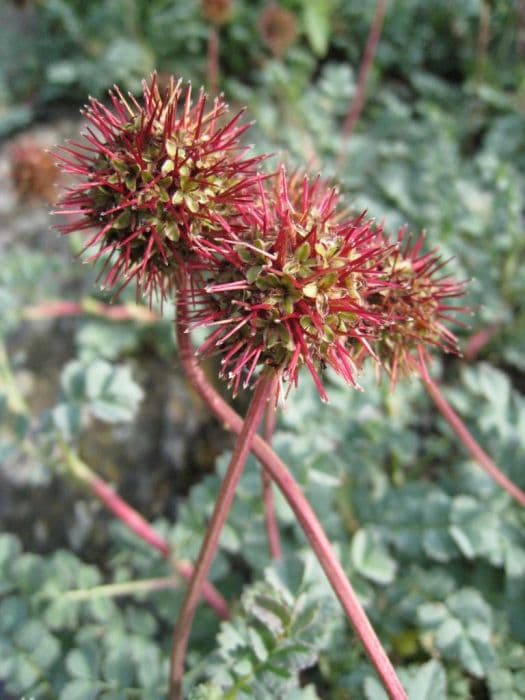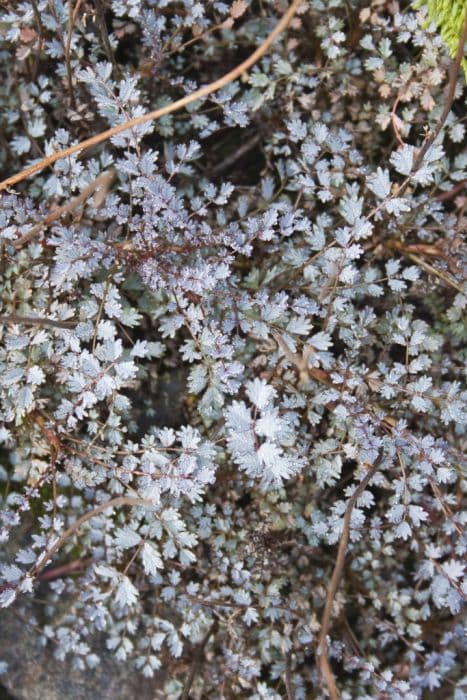Cinquefoil Potentilla nepalensis 'Miss Willmott'

ABOUT
Potentilla nepalensis 'Miss Willmott', commonly known as Nepal Cinquefoil, is a perennial plant that is highly appreciated for its ornamental qualities. Its appearance is characterized by a generous amount of bright, cheerful flowers. These blossoms are usually a warm, pink color with a darker center, creating a striking contrast. The petals are arranged in a simple, yet elegant, cup-shaped pattern, which gives the plant a delicate and charming look. The blooms are held above the foliage on slender stems, adding a sense of lightness to the plant's presence. The foliage of Nepal Cinquefoil is equally attractive, with leaves that are green and divided into five leaflets. The leaflets have toothed margins, which add texture and complexity to the plant's overall appearance. The leaves are arranged in a basal rosette formation when they first emerge, giving the plant a full and lush base. As the plant grows, the leaves spread out and create a mat-like ground cover, sporting their deep green hue and providing an excellent backdrop for the vibrant flowers.
About this plant
 Names
NamesFamily
Rosaceae
Synonyms
Cinquefoil, Nepal Cinquefoil, Miss Willmott's Cinquefoil
Common names
Potentilla nepalensis 'Miss Willmott'.
 Toxicity
ToxicityTo humans
The Potentilla, commonly known as Cinquefoil, is generally not considered toxic to humans. There is no significant evidence to suggest that Potentilla nepalensis 'Miss Willmott' poses any toxicity risk upon ingestion, and it is not commonly associated with poisoning symptoms. Therefore, accidental ingestion of this plant is unlikely to cause harm, but as with any non-food plant, ingesting large quantities may potentially lead to stomach discomfort or an allergic reaction in sensitive individuals.
To pets
The Cinquefoil is not known to be toxic to pets. Potentilla nepalensis 'Miss Willmott' does not have a reputation for being poisonous to dogs, cats, or other domestic animals, and there are no widely recognized symptoms associated with its ingestion. As always, it is prudent to discourage pets from eating ornamental plants as a precaution, and to monitor for any unusual behavior if ingestion does occur, but toxicity is not a typical concern with this species.
 Characteristics
CharacteristicsLife cycle
Perennials
Foliage type
Deciduous
Color of leaves
Green
Flower color
Pink
Height
1-2 feet (30-60 cm)
Spread
1-2 feet (30-60 cm)
Plant type
Shrub
Hardiness zones
6
Native area
Himalayas
Benefits
 General Benefits
General Benefits- Aesthetic Appeal: Adds vibrant color with its pink to red flowers, enhancing the visual interest of garden spaces.
- Drought Tolerance: Once established, it is quite tolerant to periods of drought, reducing the need for frequent watering.
- Pollinator Friendly: Attracts bees and butterflies, which are essential for pollination and maintaining healthy ecosystems.
- Low Maintenance: Requires minimal care beyond the initial establishment phase, making it suitable for gardeners of all skill levels.
- Cold Hardy: Can survive in cooler temperatures, which makes it a good choice for gardens in colder climates.
- Ground Cover: Can be used to cover bare patches in the garden, helping to reduce weed growth and soil erosion.
- Long Blooming: Flowers from late spring to early fall, providing extended interest throughout the seasons.
- Border Plant: Suitable for borders or edges in garden design, offering a neat and structured look.
- Moderate Growth Rate: Grows at a pace that is manageable and doesn't require constant pruning or attention.
 Medical Properties
Medical Properties- Anti-inflammatory: Potentilla nepalensis 'Miss Willmott' may have compounds that help reduce inflammation.
- Antioxidant: The plant may contain antioxidants that help in protecting cells from damage by free radicals.
- Antimicrobial: Some studies suggest the presence of substances in the plant that can inhibit the growth of certain bacteria and fungi.
- Astringent: The plant has historically been used for its astringent properties to help with skin issues and minor wounds.
 Air-purifying Qualities
Air-purifying QualitiesThis plant is not specifically known for air purifying qualities.
 Other Uses
Other Uses- Cinquefoil as a Dye Plant: The roots of cinquefoil can be used to produce a reddish-brown dye for fabrics or basketry materials.
- Flower Arrangements: The colorful flowers of cinquefoil can be used in bouquet arrangements to add a vibrant pop of pink or red.
- Garden Borders: Cinquefoil is a popular choice for garden borders due to its low-growing, mat-forming habit and long blooming period.
- Ground Cover: The plant spreads easily and can be used as an attractive ground cover in sunny areas of a garden.
- Erosion Control: Cinquefoil's dense growth can help prevent soil erosion on slopes or banks.
- Butterfly Garden: The flowers attract butterflies, making it a suitable choice for a butterfly garden or a pollinator-friendly landscape.
- Education: Cinquefoil's hardiness and ease of growth make it a useful plant for educational projects on botany and horticulture.
- Crafts: Dried cinquefoil flowers can be used in craft projects such as potpourri or homemade paper embellishments.
- Lawn Alternative: In areas where traditional lawns struggle, cinquefoil can be used as a low-maintenance lawn alternative.
- Culinary Garnish: While not widely recognized for culinary use, the flowers of cinquefoil can be used as an edible garnish to add visual appeal to dishes.
Interesting Facts
 Feng Shui
Feng ShuiThe Cinquefoil is not used in Feng Shui practice.
 Zodiac Sign Compitability
Zodiac Sign CompitabilityThe Cinquefoil is not used in astrology practice.
 Plant Symbolism
Plant Symbolism- Modesty: The delicate appearance of the Cinquefoil has traditionally symbolized modesty and simplicity.
- Protection: In medieval times, the Cinquefoil was believed to ward off evil spirits and was often used in protective charms.
- Beloved Mother: 'Miss Willmott' could represent a nurturing presence, possibly a tribute to a maternal figure, reflecting its namesake, Ellen Willmott, who was a prominent horticulturist.
- Maternal Love: The nurturing aspect of the Cinquefoil can also be seen as a symbol of a mother’s love and care.
- Wisdom: Due to its long history and its usage in herbal medicine, the Cinquefoil can symbolize knowledge and wisdom.
- Perseverance: As a hardy and resilient plant, it can represent one's ability to thrive in challenging conditions and persevere through hardships.
 Water
WaterCinquefoil, or 'Miss Willmott', should be watered deeply to encourage root development, so aim to water it with approximately 1 gallon of water per week, depending on the weather. In hot, dry periods, water twice a week. If the plant is established and the soil retains moisture well, reduce watering, allowing the soil to dry out slightly between waterings. Over-watering can lead to root rot, so ensure good drainage. During the winter, cut back on watering since the plant will be dormant.
 Light
LightThe Cinquefoil 'Miss Willmott' thrives best in full sun to partial shade. It is crucial to ensure that it gets at least 6 hours of sunlight daily. Planting 'Miss Willmott' in a spot that receives morning sun and afternoon shade is ideal, especially in regions with very hot summers.
 Temperature
TemperatureCinquefoil 'Miss Willmott' is a hardy plant that prefers temperate conditions and can survive in temperatures as low as -30 degrees Fahrenheit. Its ideal growing temperature is between 60 and 70 degrees Fahrenheit. Avoid exposing the plant to prolonged temperatures above 85 degrees Fahrenheit as it may stress the plant.
 Pruning
PruningPrune Cinquefoil 'Miss Willmott' to shape the plant and remove dead or diseased wood; this improves the plant's health and appearance. The best time to prune is in late winter or early spring before new growth starts. Typically, pruning can be done annually.
 Cleaning
CleaningAs needed
 Soil
SoilCinquefoil requires well-draining, loamy soil with a pH range of 6.0 to 7.5. A mixture of garden soil, sand, and compost will create an ideal growing medium for 'Miss Willmott'. Ensure ample organic matter for nutrient retention and drainage optimization.
 Repotting
Repotting'Miss Willmott' Cinquefoil does not require frequent repotting. Repot every 2 to 3 years to refresh the soil or when the plant has outgrown its current container.
 Humidity & Misting
Humidity & MistingCinquefoil prefers average humidity levels and does not require any special humidity adjustments. It is adaptable to the humidity conditions typically found in natural outdoor environments.
 Suitable locations
Suitable locationsIndoor
Ensure bright light, cool conditions, and well-draining soil.
Outdoor
Plant in sun to part shade in well-drained soil.
Hardiness zone
5-7 USDA
 Life cycle
Life cyclePotentilla nepalensis 'Miss Willmott', commonly known as Nepal Cinquefoil, begins its life as a seed that germinates in late winter or spring when soil temperatures become favorable. The seedling emerges and develops a rosette of leaves during its first growing season, establishing a root system. As it matures into its second year, the Nepal Cinquefoil grows taller stems and leafier shoots, preparing for the flowering stage. It flowers in early to mid-summer, producing pink to raspberry-colored flowers that attract pollinators and subsequently set seed. After flowering, the plant may go into a dormant phase in late fall or winter, especially in cooler climates. The Nepal Cinquefoil is a perennial herb, so it will re-emerge from its rootstock the following spring to repeat the cycle, often living for several years.
 Propogation
PropogationPropogation time
Spring to Summer
The Potentilla nepalensis 'Miss Willmott', commonly known as the Cinquefoil, is best propagated by division in the spring. To do this, carefully dig up the plant, making sure to keep a good amount of soil around the roots. Separate the clump into smaller sections, each with several shoots and a healthy supply of roots. Replant the sections at the same depth they were originally growing at in well-draining soil, spacing them about 12 to 24 inches (approximately 30 to 61 centimeters) apart. Water the new divisions thoroughly to help establish them. This method of division helps to maintain the vigor of the Cinquefoil and is a popular choice for gardeners wanting to propagate this hardy perennial.









